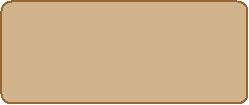
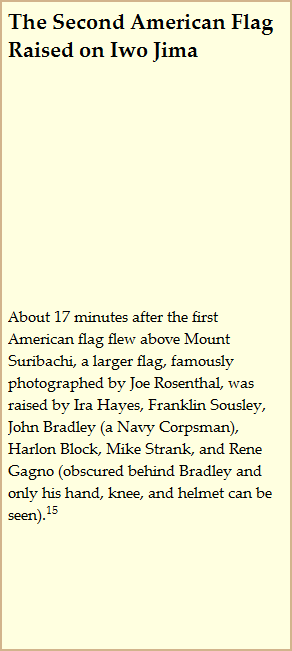



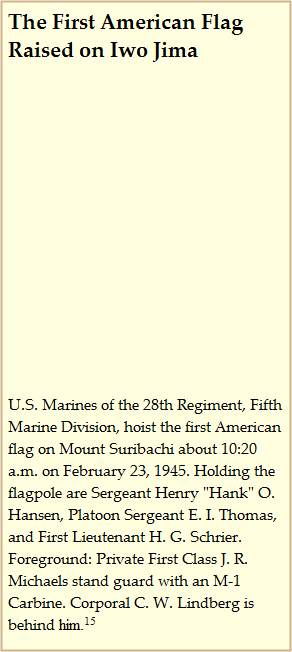
|
Here are some fascinating facts from Bradley's book, Flag of Our Fathers:4 |
Mount Suribachi and the Two Flag Raisings.
For some reason, the 150 Japanese on Mount Suribachi attacked the small, 40-man patrol of U.S. Marines only once even though the Japanese outnumbered the Americans four to one.8
Over the course of months, Iwo Jima was used as an emergency landing base for more than 2,400 B-29 bombers carrying over 27,000 crewman. The airfields on Iwo Jima and the location of the island saved the lives of many Americans.11
The first flag was provided by Col. Chandler Johnson of the U.S.M.C. Second Battalion who was killed in action on March 8, 1945.6
First flag raised on February 23, 1945 at 10:20 a.m. on day 4 of 36 to the cheers of thousands of Marines who saw the flag go up.7
When Secretary of Defense James Forrestal saw the flag flying later that day he wanted the flag for a souvenir. When Colonel Johnson, who had provided the first flag, heard of this, he was not happy. He felt the flag belonged to his battalion. Johnson got a larger replacement flag and secured the first flag for the Second Battalion. A replacement flag, larger than the first one, measuring 96" x 56" was found on the LST-779. The landing craft was on the beach and had been rescued from a Pearl Harbor salvage yard and came from a ship that sank on December 7, 1941.9
The pole for the second flag was a drainage pipe and weighed more than 100 pounds (p. 209). The raising of the second, larger, flag generated no interest from the troops. This flag was only a replacement. After three weeks in the heavy winds of Iwo Jima, this flag was in tatters.9
The photograph of the second flag raising was luck. Joe Rosenthal was talking to the military photographer and almost missed the shot and the first two pictures on the roll of film were washed out by light as Rosenthal was not looking through the viewfinder when he took the picture.10 |
Iwo Jima Headlines from The New York Times:12
2/19/1945 Monday: U.S. Marines Storm ashore on Iwo island
2/20/1945 Tuesday: Marines Fight Way to Airfield on Iwo Aisle
2/21/1945 Wednesday: Marines Conquer Airfield, Hold Third of Iwo
2/22/1945 Thursday: Marines Halted on Iwo...800 ships Aid Landing. On page 4 of the paper, casualty count starts with a headline of "Marines' Hardest Fight" and states 3,650 Marines dead and "our first waves on Iwo were almost wiped out."
2/23/1945 Friday: Marines Take Suribachi, Chief Point on Iwo (but no photos accompanied article). Other headlines that day: "Volcano is seized - Marines Put Flag Atop Suribachi's Crest" and "Japanese Hit Back - Our Casualties at 5,372."
2/24/1945 Saturday: Marines Gain Slowly in Center of Iwo
2/25/1945 Sunday: One of the headlines: "Marines Win Half of Iwo's Central Airfield" and the Rosenthal photograph of the second flag raising with the headline of "Old Glory Goes Up Over Iwo" and the caption "Marines of the Fifth Division Hoist the American Flag Atop Mount Suribachi."
New York Times Headlines with incorrect/inaccurate stories:13
"Suribachi Reached in Fiery Battle"
"Way to Volcano's Base Burned with Flamethrowers Prior to Scaling of Volcano"
"Ascent Made By Marines As Japanese Hurled Grenades and Poured Bullets on Them" |

This page provides a brief history of the Battle for Iwo Jima during World War 2 and an excellent 1945 documentary - filmed in color! The page also includes some background information.
By the time the United States entered World War Two in 1941, the Empire of Japan had spread all over the Pacific and into mainland China. By 1945, America was having success pushing back Japan toward her home island.
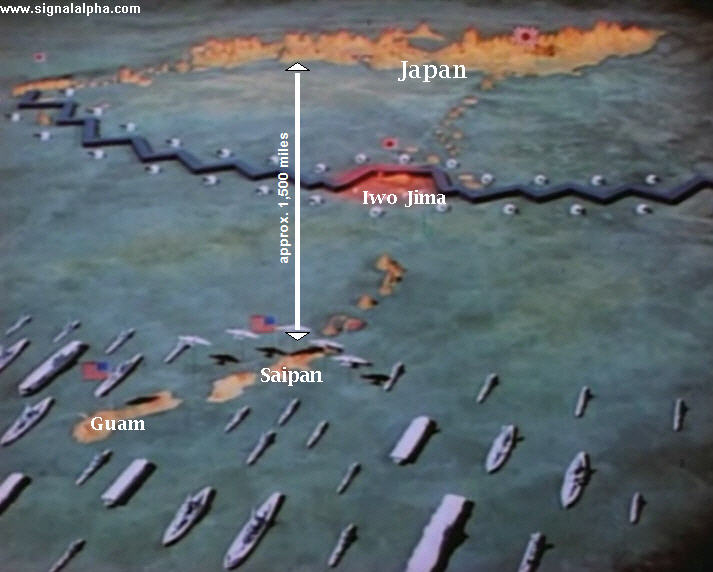
This was a time before smart bombs, cruise missiles, and aircraft that could fly around the world by refueling in the air. In 1945, ground air bases were a necessity. Although long-range bombers like the B-29 Superfortress could fly from bases in Saipan and bomb Tokyo more than 1,500 miles away, no fighter planes, to provide protection to the bombers, were able to make that distance. Fighter planes needed an air base from which to operate. American strategy in the Pacific involved taking possession of small islands in the Pacific and to use them for air bases. Two of the islands on the march toward Japan were Guam and Saipan. Both involved battles with the Japanese and the battles inflected heavy losses on both participants.
Battle of Saipan
The battle for Saipan was fought from June 15, 1944 through July 9, 1944. Almost 3,000 Americans were killed and over 10,000 were wounded1. The losses for the Japanese were worse: 22,000 civilians dead and over 30,000 soldiers.1
The next island stepping stone was Iwo Jima and the casualties to be suffered were going to be heavy there too.
Battle of Iwo Jima
Iwo Jima is an eight-square mile spec of a volcanic island in the Pacific Ocean, about 760 miles - only four hours flying time - to Tokyo. Japan fortified Iwo Jima with miles of underground tunnels, caves, pill boxes and over 20,000 troops. The United States wanted the island for use as air base to launch fighter plans and to serve as an emergency landing strip for damaged bombers returned from their bombing run on Japan.
The battle for Iwo Jima started on February 19, 1945 with naval bombardment to "soften" the Japanese positions on the island. Because of the hardened fortifications, the bombardment did not have the desired results - The Japanese were fully capable of mounting an effective defense.
The more than 21,000 Japanese defenders, under the command of Lieutenant General Kuribayashi Tadamichi fought ferociously. During the intense battles, Japanese kamikaze counterattacks sank the American light carrier Bismark Sea and other American ships were damaged.2 On the island, the Japanese fired upon Americans from the underground garrisons, caves, and "pill boxes", fortified positions of steel and concrete. The Marines had to fight and "dig them out" one position at a time, using grenades, flame throwers, and rifle fire.
The taking of Mount Suribachi on the south end of the island on February 23 did not end the fighting. In fact, the island was not declared secure for American forces until March 16, 1945.2
Over the many weeks after the battle began, the United States incurred more than 28,000 casualties, over 6,800 deaths.3 Nearly all 21,000 the Japanese defenders were killed.3 Only about 1,000 were captured alive.3 They had survived by raiding American supplies.
Once Iwo Jima was secured, the air base on the island was used for the fire bombings of Japan. The firebombing of Tokyo on March 9, 1945 killed 100,000 Japanese and wounded 125,000.5
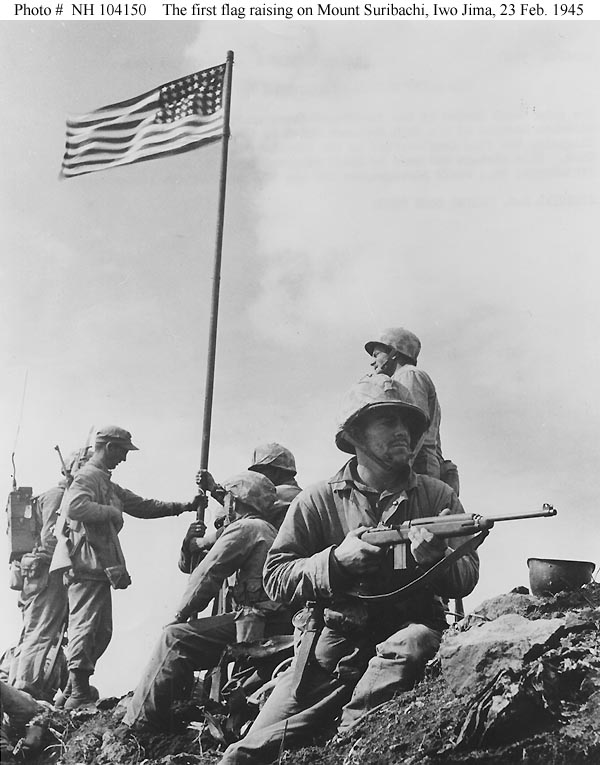
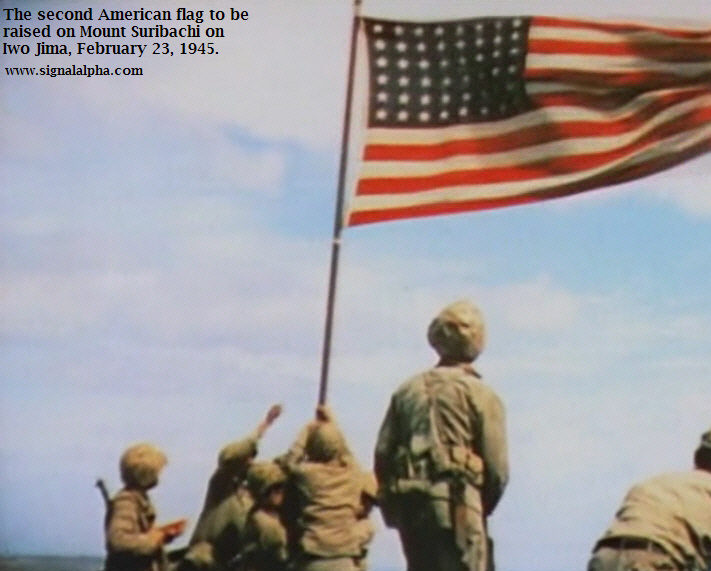
Iwo Jima was administered by the United States from 1945 until 1968 when the United States relinquished control back to Japan.3 I think this battle, as well as battles for many other small Pacific islands, the magnitude of losses America was enduring, and the estimated loss of life when the United States invaded Japan is instructive of why President Harry Truman reasoned the use of atomic weapons on Japan was the best option. For more information on this topic, please go to the Atomic Bomb page.
Citations:
1 John Toland, The Rising Sun: The Decline and Fall of the Japanese Empire 1936 - 1945, Random House, 1970, page 516.
2 The New Encyclopedia Britannica, Macropedia Volume 29, 15th Edition, copyright 2007, page 1021.
3 The New Encyclopedia Britannica, Micropedia Ready Reference, Volume 6, 15th Edition, copyright 2007, "Iwo Jima", page 446.
4 James Bradley with Ron Powers, Flags of Our Fathers, Bantam, 2006.
5 James Bradley with Ron Powers, Flags of Our Fathers, Bantam, 2006, page 240.
6 James Bradley with Ron Powers, Flags of Our Fathers, Bantam, 2006, page 234.
7 James Bradley with Ron Powers, Flags of Our Fathers, Bantam, 2006, page 204.
8 James Bradley with Ron Powers, Flags of Our Fathers, Bantam, 2006, page 206.
9 James Bradley with Ron Powers, Flags of Our Fathers, Bantam, 2006, page 209.
10 James Bradley with Ron Powers, Flags of Our Fathers, Bantam, 2006, page 216.
11 James Bradley with Ron Powers, Flags of Our Fathers, Bantam, 2006, page 247.
12 James Bradley with Ron Powers, Flags of Our Fathers, Bantam, 2006, page 218.
13 James Bradley with Ron Powers, Flags of Our Fathers, Bantam, 2006, page 223.
14 Clip is from the documentary To the Shores of Iwo Jima, United States Office of War Information, 1945.
15 Navy Historical Center, Department of the Navy: www.history.navy.mil/photos/images/i04000/i04150c.htm
To the Shores of Iwo Jima is a 20-minute documentary released in 1945. The movie was edited by Warner Brothers for the U.S. Government Office of War Information and details the battle for Iwo Jima. There are many battle scenes and a good narrative.
Click here or on the film's title page to watch the video.
Raising the American Flag Over Iwo Jima
Many people are not aware, there were actually two flags hoisted over Mount Suribachi. The famous picture taken by photographer Joe Rosenthal was the second flag raised that day. James Bradley, with Ron Powers, wrote Flag of Our Fathers, a book about the events and people who raised the second flag. John Bradley, who helped raise the second flag, is the author's father.
Click here or on the player icon to launch a short color video clip of the second flag raising14
The March 19, 1945 Universal Newsreel offers a summary of the events on Iwo Jima. Click here to watch the video.
Please note: The audio and video on this page require Windows Media Player. The player will launch in a new window and the media may take a few moments to load.







